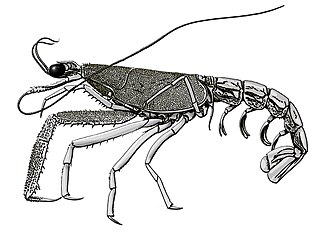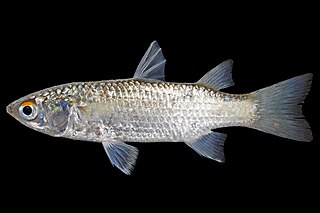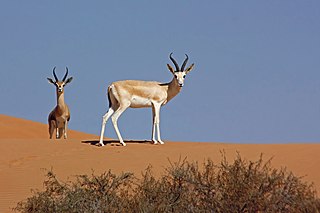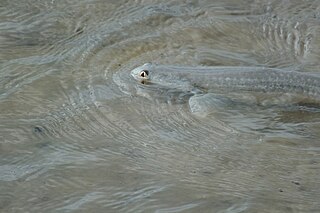
The Noctilucales are an order of marine dinoflagellates. They differ from most others in that the mature cell is diploid and its nucleus does not show a dinokaryotic organization. They show gametic meiosis.

The Caenophidia are a derived clade of alethinophidian snakes, which contains over 80% of all the extant species of snakes. The largest family is Colubridae, but it also includes at least seven other families, at least four of which were once classified as "Colubridae" before molecular phylogenetics helped us understand their relationships. It has been found to be monophyletic.

The lesser short-tailed gerbil is distributed mainly from eastern Morocco to Egypt. It is also known as Simon's dipodil. After morphological and molecular studies in 2010 Dipodillus was ranged as a subgenus of Gerbillus, and Dipodillus simoni was renamed into Gerbillus simoni.

The giant coua is a bird species from the coua genus in the cuckoo family that is endemic to the dry forests of western and southern Madagascar. It is suggested that couas probably originated from a particular Asian ground-cuckoo. The genus coua contains 10 species, more than any other genus in Madagascar. Although the bird is listed under least concern (LC) in the IUCN Red List of Threatened Species, it only persists in the biological hot spot of Madagascar, warranting its recognition as a species of conservation concern at the global scale.

Dipodillus is a genus of rodent in the family Muridae. It is sometimes classified as a subgenus of the genus Gerbillus.

Humerana lateralis is a species of frog in the family Ranidae. It is found in Cambodia, Laos, Myanmar, Thailand, and Vietnam. It is commonly known as Kokarit frog, yellow frog or (ambiguously) wood frog.

Neotrygon is a genus of stingrays in the family Dasyatidae commonly known as the Maskrays, native to the Indo-West Pacific. They are so named because of a distinctive color pattern around their eyes, resembling a mask. The species in this genus were originally placed in the genus Dasyatis by most authors. However, recent morphological and molecular analyses have conclusively showed that they represent a distinct group and so the genus Neotrygon was resurrected for them.

Laurentaeglyphea neocaledonica is a species of glypheoid lobster, and the only species in the genus Laurentaeglyphea. It is known from a single specimen collected on a guyot in the Coral Sea between Australia and New Caledonia. It is thought to be an active predator with colour vision, unlike its nearest living relative, Neoglyphea inopinata.

Vietbocap thienduongensis is a species of scorpion in the family Pseudochactidae. This species was described by Phạm Đình Sắc and Wilson Lourenço inside Thiên Đường Cave, a cave located in Phong Nha-Kẻ Bàng National Park, Quảng Bình Province, Vietnam.
Conlephasma enigma is a wingless, ground-dwelling species of stick insect in the monotypic genus Conlephasma, and is found on Mount Halcon, on the Philippine island of Mindoro.
Grossicis is a genus of tree-fungus beetle in the family Ciidae.

The Pseudochactidae are a scorpion family. They are predominantly found in caves.

Vietbocap canhi is a species of troglobiontic scorpions in the family Pseudochactidae native to Vietnam.

Planiliza is a genus of mullets found in coastal marine waters, estuaries and rivers in the Indo-Pacific.

The Arabian sand gazelle or reem is a species of gazelle native to the West Asia, specifically the Arabian and Syrian Deserts.

Diploglossa is a clade of neoanguimorphs represented by the families Xenosauridae, Diploglossidae, Anniellidae and Anguidae, the latter three placed in the superfamily Anguioidea. In the past the Chinese crocodile lizard was classified as a xenosaurid; current molecular work has shown evidence the species related to varanoids in the clade Paleoanguimorpha.

The shark mullet, also known as the sharp-nosed mullet, popeye mullet, or skipjack mullet, is a species of ray-finned fish from the grey mullet family Mugilidae. It is found in Australia and New Guinea where it occurs in muddy freshwater habitats and mangroves, it feeds on algae and insects taken from the surface but also on benthic invertebrates. It can breathe air and sometimes moves over exposed mud by wriggling. It was formerly classified in the genus Rhinomugil, with the corsula, but is now placed in its own monospecific genus, Squalomugil.
Burmese amber is fossil resin dating to the early Late Cretaceous Cenomanian age recovered from deposits in the Hukawng Valley of northern Myanmar. It is known for being one of the most diverse Cretaceous age amber paleobiotas, containing rich arthropod fossils, along with uncommon vertebrate fossils and even rare marine inclusions. A mostly complete list of all taxa described up until 2018 can be found in Ross 2018; its supplement Ross 2019b covers most of 2019.

Reddyanus is a genus of buthid scorpions native to Oriental region from India, Sri Lanka, China: Tibet, to Melanesia. The genus was previously described as a subgenus of Isometrus.
Belisarius ibericus is a species of scorpion in the family Belisariidae.














